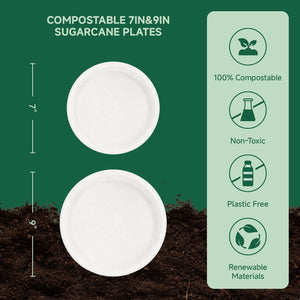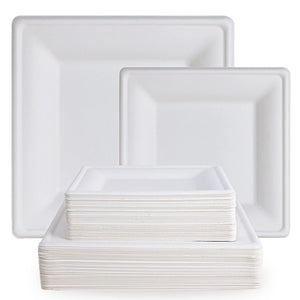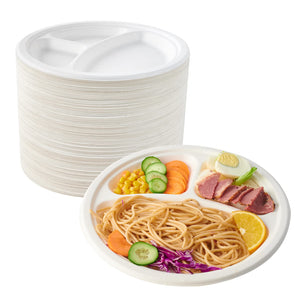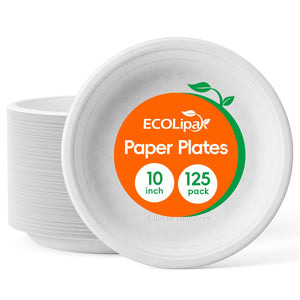You might think your disposable plates are helping the planet. Here is a surprising fact. Most are neither truly compostable nor paper plates biodegradable. A hidden plastic or wax coating stops them from breaking down properly. This makes choosing eco-friendly disposable dinnerware tricky.
Tip: Always look for certified compostable plates. This term is regulated. "Biodegradable" often is not. Understanding the difference between compostable and biodegradable helps you make a better choice for your disposable plates.
UNDERSTANDING COMPOSTABLE PLATES
Compostable is a regulated term with a clear promise. It means an item can break down into natural, non-toxic elements. This process creates a valuable resource instead of just more trash. Let's explore what makes compostable plates a truly green choice.
THE OFFICIAL DEFINITION
You will find that true compostable products must meet strict legal standards. For example, the ASTM D6400 and D6868 standards define the rules for compostable packaging and plastics. These rules ensure items break down completely.
A product is only certified compostable if it can:
Break down into natural materials within 90 to 180 days in a commercial facility.
Leave behind no toxic residue.
Become nutrient-rich soil, also known as humus.
These standards guarantee that certified compostable plates are designed for effective composting.
THE ENVIRONMENTAL BENEFIT
Choosing compostable plates helps you reduce your environmental impact. When regular food scraps and disposable plates go to a landfill, they decompose without oxygen. This process releases methane, a greenhouse gas over 25 times more potent than carbon dioxide. Composting avoids this problem entirely. The composting process requires oxygen, which prevents methane production. You turn waste from your party into a resource for gardens and farms. Using environmentally friendly compostable goods is a smart way to fight climate change.
THE CORRECT DISPOSAL METHOD
Proper disposal is key to unlocking the benefits of compostable products. You cannot simply toss these items in your backyard bin or recycling.
Commercial Facility Required: Certified compostable plates and compostable packaging need the high heat of an industrial composting facility to break down correctly. Your backyard pile does not get hot enough.
Check Local Access: Before you buy, check if your community has a commercial composting program that accepts these items. Many facilities only take BPI or CMA-certified products.
Avoid Contamination: Never put these disposable plates in the recycling bin. They will contaminate the recycling stream. Some items are labeled for home compostable use, but most require industrial composting.
When you dispose of them correctly, you complete the cycle of composting.
THE TRUTH ABOUT PAPER PLATES BIODEGRADABLE
The word "biodegradable" on a package of disposable plates can make you feel good about your purchase. However, this term is often misleading. Unlike "compostable," it is not a regulated claim. Understanding the truth about paper plates biodegradable helps you see the real story behind the label.
A VAGUE AND UNREGULATED TERM
You will find that "biodegradable" simply means something can be broken down by microorganisms. The problem is that the term does not specify a timeframe. A product could take hundreds of years to break down and still be called biodegradable.
The U.S. Federal Trade Commission (FTC) warns marketers against making vague environmental claims. The FTC's Green Guides state that if a product is headed for a landfill, companies should not claim it is biodegradable without explaining how long it will take to decompose. Some states are even stricter.
California law, for example, now restricts the use of terms like 'biodegradable' on all consumer products. This rule aims to prevent you from being misled about the environmental impact of what you buy. Washington also has tight rules, showing a growing trend against these confusing labels.
These regulations exist because most biodegradable products do not break down as you might expect.
THE MICROPLASTICS PROBLEM
Many paper plates biodegradable have a thin plastic or wax coating. This coating prevents leaks but creates a serious pollution problem. When you throw these disposable plates away, that plastic lining does not just disappear.
A study from Michigan State University explains the process. Environmental forces like sunlight and water break the plastic coating into tiny pieces. These pieces are called microplastics. These harmful particles can contaminate soil and enter our waterways. This means the biodegradable plates you used can become a source of plastic pollution.
Many grease-resistant disposable plates also contain harmful chemicals. These are often from a group of "forever chemicals" called PFAS.
PFAS chemicals can leak from the plates into your food.
They persist in the environment for a very long time.
When you throw away products with PFAS, the chemicals can move into the soil, air, and water.
These hidden dangers show that many biodegradable plastics are not a safe choice.
THE REALITY OF DISPOSAL
So, where should you put these plates? The answer is simple: they belong in the trash. They cannot be recycled because of the plastic coating and food residue. They also do not belong in a compost pile.
When these plates end up in a landfill, they face another problem. Modern landfills are designed to be very compact and have little oxygen. After about a year, waste begins to break down anaerobically, or without oxygen. This process is extremely slow. In 2018 alone, Americans threw away 2.5 million tons of paper and plastic plates and cups.
The paper part of the plate may slowly decompose over many years. The plastic lining, however, will not. It remains for a very long time.
Material |
Approximate Time to Decompose in a Landfill |
|---|---|
PE-Lined Paper (like on plates) |
20+ years |
Laminated Paper |
Potentially hundreds of years |
Ultimately, these plates take up space in landfills for decades, and their plastic components persist indefinitely.
HOW TO SPOT A TRULY COMPOSTABLE PLATE
Navigating the grocery aisle for disposable plates can feel like a pop quiz. Many packages use confusing words and symbols. You can learn to spot the truly sustainable options. This guide will show you how to become an expert at identifying genuinely compostable plates.
LOOK FOR CERTIFICATIONS, NOT CLAIMS
You should first learn to ignore vague marketing buzzwords. Companies often use misleading terms on their eco-friendly packaging to make you think a product is greener than it is. This practice is called "greenwashing."
Be cautious of these common but unregulated claims:
Degradable or Decomposable
Eco or Bio
Earth-Friendly
Packaging that is colored green to suggest it is an eco-friendly choice
These words do not guarantee a product will break down quickly or safely. In fact, some states like California, Washington, and Maryland have laws that restrict companies from using the word 'biodegradable' on packaging. These rules exist to protect you from false advertising. Some companies have even faced lawsuits for making misleading claims. For instance, a class-action lawsuit was filed against companies for marketing their disposable plates as compostable when they contained "forever chemicals" (PFAS), which do not break down. This shows why you must rely on official certifications, not just words on a box.
KEY CERTIFICATION LOGOS
Official certifications are your best tool for finding authentic compostable products. These logos prove that a product has passed strict, scientific tests. You can find these logos printed directly on the compostable packaging.
Here are the key certifications you can trust:
BPI (Biodegradable Products Institute): This is the most common certification in North America. For a product to earn the BPI logo, it must undergo intense lab testing. These tests ensure the product breaks down, disintegrates completely, and leaves no toxic residue. BPI has a strict policy against PFAS, requiring that all certified compostable products contain no intentionally added fluorinated chemicals.
CMA (Compost Manufacturing Alliance): The CMA was created by compost manufacturers themselves. They wanted to ensure products would break down in their real-world facilities. CMA certification includes all the necessary lab tests plus a field test in a large-scale composting environment. Some facilities now only accept CMA-certified items because they are proven to work in practice.
TÜV AUSTRIA (OK compost): This is a widely respected European certification. You may see the "OK compost INDUSTRIAL" or "OK compost HOME" logos on products sold in the U.S. The "HOME" certification is special because it guarantees the item can break down in a backyard compost pile.
Certification |
What It Guarantees |
Best For |
|---|---|---|
BPI |
Passes strict lab tests for compostability (ASTM D6400). |
Verifying a product is scientifically designed to be composted. |
CMA |
Passes lab tests AND real-world field tests in industrial facilities. |
Ensuring a product is accepted by and works in commercial compost programs. |
TÜV AUSTRIA |
Passes European lab standards for industrial or home composting. |
Identifying products that meet international standards. |
Pro Tip: You can verify a product's certification online. Most certifiers, like BPI and DIN CERTCO (for TÜV), have public databases on their websites. You can search for the product or company to confirm its status.
CHECK THE PLATE MATERIAL
After you look for a certification logo, the material of the disposable plates gives you more clues. Genuinely compostable plates are made from plant-based fibers. They feel natural, not slick or plasticky.
Avoid any disposable plates with a shiny, plastic-like coating unless the package has a BPI or CMA logo. That sheen often comes from a petroleum-based plastic or a PFAS coating, neither of which will compost. Many paper plates, and even some bagasse plates, use these coatings to resist moisture, which contaminates the composting process and can be a risk to your health.
Look for these excellent materials instead:
-
Sugarcane (Bagasse): This is one of the best materials for compostable plates. Bagasse is the dry, pulpy fiber left over after sugarcane stalks are crushed for their juice. It is a brilliant use of an agricultural byproduct.
Sturdy and Strong: It holds up well against heavy, wet, or oily foods.
Heat Resistant: You can safely use it in the microwave.
Truly Compostable: It breaks down into nutrient-rich soil in 60-90 days in a commercial facility without leaving behind microplastics.
Palm Leaf: These elegant plates are made from naturally fallen Areca palm leaves. Workers collect, clean, and press the leaves into shape using only heat and water. No chemicals, glues, or bonding agents are used. This 100% natural composition means they are completely biodegradable and compostable.
Bamboo: Bamboo is a fast-growing, renewable resource. Certified bamboo plates are a safe and sturdy option. The material is naturally resistant to bacteria and does not require harmful chemical coatings. Always look for trusted manufacturers who have their products certified by organizations like BPI to ensure they are safe for food and truly compostable.
By checking for both a certification and a natural material, you can confidently choose compostable plates that are better for you and the planet.
You can now make smart, eco-conscious choices. Remember this simple hierarchy for your disposable plates.
Choose Certified: Always pick certified compostable plates over those labeled "paper plates biodegradable."
Dispose Correctly: Send certified items to a commercial composting facility. All other plates go in the trash. Never recycle them.
Reduce First: The most sustainable alternative is always a reusable plate. This option saves water and reduces waste from manufacturing and composting.
Following these steps for composting makes you part of the solution. Using a sustainable alternative makes an even bigger impact.
FAQ
Can I compost paper plates at home?
You should avoid putting most compostable plates in a home compost pile. They need the high heat of an industrial facility to break down correctly. Look for the "OK compost HOME" certification if you want to compost items in your backyard bin.
Why can't I recycle paper plates?
You cannot recycle paper plates because of contamination. Food residue and grease ruin the paper fibers.
The plastic or wax coating on most plates also makes them unacceptable for recycling facilities. They must go in the trash.
Are biodegradable plates a good choice? ❌
You should not rely on the term "biodegradable." It is an unregulated claim and does not guarantee a product is eco-friendly. Many of these plates contain plastic and will not break down properly. Always choose certified compostable plates instead for a better environmental impact.
How do I find a commercial composting facility?
You can find a local composting service with a quick search.
Check your city or county's waste management website for local programs.
Use online tools like FindAComposter.com to locate a facility near you.









